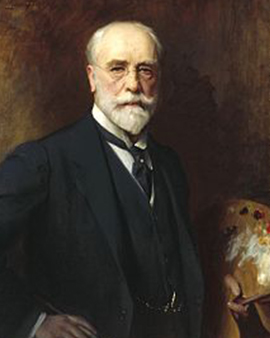


The British painter and illustrator is known above all for his works, some of which are critical of society. This commitment is not by chance; his grandmother Mary Fildes was known as an activist and campaigned for women's rights as president of the Manchester Female Reform Society. The effects of industrialisation not only had a lasting impact on the country, but also had a major influence on the artist's work. Fildes successfully used his talent to draw attention to the problems of the time.
Samuel Luke Fildes grew up in the late Victorian era, when London in particular was experiencing the effects of the final stadium of industrialisation. This was particularly visible in the streets. Hunger, poverty, and death were omnipresent - themes that are often reflected in Fildes' art. Born in Liverpool, the artist made London his new home at the age of 17 to attend South Kensington Art School. There he met Hubert von Herkomer and Frank Holl. All three artists found inspiration in the work of Frederick Walker, the pioneer of the British Socialist Realism movement. Fildes believed above all in the power of the image and joined the editorial staff of the socially critical weekly magazine "The Graphic" as an illustrator, led by the social reformer William Luson Thomas. His black and white illustrations were also popular on the continent. The situation in the English capital nevertheless remained a central theme of his work under the eyes of an international audience. Author Charles Dickens was also a great admirer of Bild's work. Through the Pre-Raphaelite John Everett Millais, the author became aware of Bilde's talent and eye for social injustice. Dickens was so impressed by Filde's work on the newly adopted Houseless Poor Act that he immediately commissioned an illustration for "The Secret of Edwin Droods". The novel remained unfinished after the author's sudden death.
Fildes quickly became known for his socially critical illustrations and in 1870 withdrew completely from working for the print media. He now devoted himself exclusively to oil painting and made a name for himself as one of the most capable artists of his generation. In 1887, Fildes was officially recognised as a Royal Academician by the Royal Academy and was knighted by King George VII in 1906. He married Fanny Woods, also an artist and sister of the neo-Venetian painter Henry Woods. Fanny's first son died early of typhoid fever, a theme which he treated in 1891 with the painting "The Doctor". The suffering of the poor plays a central role in his works, but portraits and paintings depicting life in Venice also demonstrate Bild's talent and eye for detail.

The British painter and illustrator is known above all for his works, some of which are critical of society. This commitment is not by chance; his grandmother Mary Fildes was known as an activist and campaigned for women's rights as president of the Manchester Female Reform Society. The effects of industrialisation not only had a lasting impact on the country, but also had a major influence on the artist's work. Fildes successfully used his talent to draw attention to the problems of the time.
Samuel Luke Fildes grew up in the late Victorian era, when London in particular was experiencing the effects of the final stadium of industrialisation. This was particularly visible in the streets. Hunger, poverty, and death were omnipresent - themes that are often reflected in Fildes' art. Born in Liverpool, the artist made London his new home at the age of 17 to attend South Kensington Art School. There he met Hubert von Herkomer and Frank Holl. All three artists found inspiration in the work of Frederick Walker, the pioneer of the British Socialist Realism movement. Fildes believed above all in the power of the image and joined the editorial staff of the socially critical weekly magazine "The Graphic" as an illustrator, led by the social reformer William Luson Thomas. His black and white illustrations were also popular on the continent. The situation in the English capital nevertheless remained a central theme of his work under the eyes of an international audience. Author Charles Dickens was also a great admirer of Bild's work. Through the Pre-Raphaelite John Everett Millais, the author became aware of Bilde's talent and eye for social injustice. Dickens was so impressed by Filde's work on the newly adopted Houseless Poor Act that he immediately commissioned an illustration for "The Secret of Edwin Droods". The novel remained unfinished after the author's sudden death.
Fildes quickly became known for his socially critical illustrations and in 1870 withdrew completely from working for the print media. He now devoted himself exclusively to oil painting and made a name for himself as one of the most capable artists of his generation. In 1887, Fildes was officially recognised as a Royal Academician by the Royal Academy and was knighted by King George VII in 1906. He married Fanny Woods, also an artist and sister of the neo-Venetian painter Henry Woods. Fanny's first son died early of typhoid fever, a theme which he treated in 1891 with the painting "The Doctor". The suffering of the poor plays a central role in his works, but portraits and paintings depicting life in Venice also demonstrate Bild's talent and eye for detail.
Page 1 / 1






